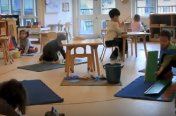By: Emma Wong Singh

Movement and Learning
Long before modern day research ‘discovered’ that active movement (as opposed to the passive movement of being pushed in a pram, being placed in a cot or playpen, or in a baby-walker) has a significant positive impact on the basic developmental processes the child experiences, Maria Montessori had grasped the importance of that very same relationship. From her observations of children over the first quarter of last century, she asserted that, ‘…mental development must be connected with movement and be dependent on it.’ And claimed further that, ‘(the child needs) activity concentrated on some task that requires movement of the hands guided by the intellect.’
She discovered that movement needs to be ‘…guided by the intellect’; movement not for movement’s sake, but purposeful movement.
After the initial 1963 classic study by Held and Hein many more pieces of research began to explore the impact of grasping and also crawling on babies’ brain development. These studies found that the more active the infant was in exploring the environment with their hands, the more advanced they were in their ability to perceive object boundaries. Recent research with monkeys and adult humans have also found that we respond to what we can interact with, and once babies reach for objects, we can see that they become capable of interacting with their environment; the earlier they start to reach, the earlier their cognitive abilities mature. This interaction, it was further proved, also increased their interest in and knowledge of the physical world around them and also interestingly, their mental world, i.e. being able to share other peoples’ experiences.
Furthermore, recent research suggests the importance of goal orientated movement. The assertion made by Angeline Stoll Lillard after having laid bare the evidence in her book is that, ‘Purposeful movement appears to be associated with neurological change; mere movement does not.’
Our Task: Helping the Child to Help Himself
Meaningful exercise requires the adult to prepare for the child activities that allow him to master the direction of his movements:
When he is just newly born, hang a beautiful mobile that moves gently with any passing current, so that his eyes can track the outlines of the abstract shapes and colours.
When he is a little older, provide low mobiles (a bell attached to a ribbon for example) just within his reach, and just the right size for his small hands, to grasp and to feel the incredible power of ‘I can do it by myself!’
When he develops his pincer grip at around 9 months, give him items small enough for him to hold and manipulate as this type of aid will help him use and perfect his new developmental acquisition
When he is 18 months old, give him practical life activities that are easy to prepare in the home, for example, washing tomatoes, picking the leaves off radishes, cutting bananas with a ‘butter’ knife, laying the table, watering the plants, loading the washing machine, un-stacking the dishwasher. Ensure that the challenge is commensurate with his ability; the more experience he receives, the more complex activities he will be able to perform
The joy in the child is self-evident when we watch him perform what to the adult seem like ‘chores’ around the house. Such practical, meaningful activities help him feel like [and so he becomes] a responsible and contributing member of the family; little does he know that every opportunity set, allows his intellectual life to flourish in the form of the ‘I think and then I do’ process.
But please,
- Respect his work as his own
- Be observers and not doers of his work
- And be prepared to watch him repeat the activity over and over again
‘Watching a child makes it obvious that the development of his mind comes about through his movements……Observations made on children the world over confirm that the child uses his movements to extend his understanding. Movement helps the development of mind, and this finds renewed expression in further movement and activity. It follows that we are dealing with a cycle, because mind and movement are parts of the same entity.’
 Suggested further reading:
Suggested further reading:
Montessori: The Science Behind The Genius by Angeline Stoll Lillard. View
How Babies Think by Alison Gopnick, Andrew Meltzoff and Patricia Kuhl
What’s Going On In There? How the Brain and Mind Develop in the First Five Years of Life by Lise Eliot, PhD
Understanding the Human Being by Silvana Montanaro MD View
The Absorbent Mind by Maria Montessori View
What You Should Know About Your Child by Maria Montessori View
The Child in the Family by Maria Montessori